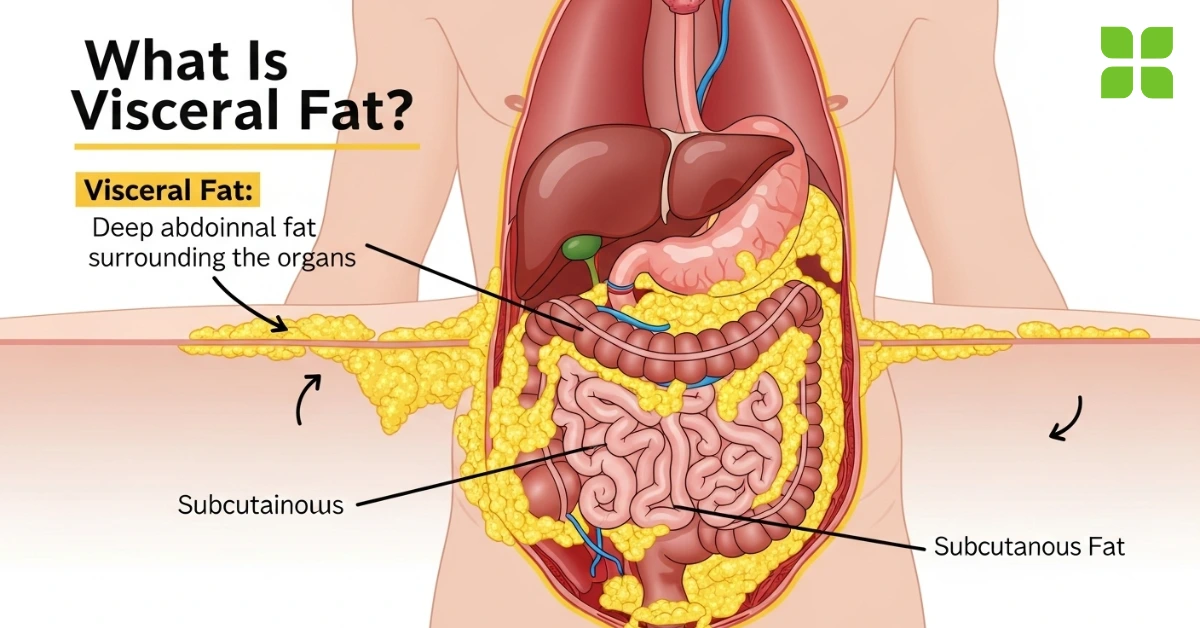Belly fat that is located deep within the abdominal cavity is known as visceral fat. It envelops vital organs such as your intestines, liver, and stomach. Subcutaneous fat, or fat directly beneath the skin, is not the same as this. In actuality, visceral fat poses a greater risk to your health. The two most effective strategies to stop visceral fat from accumulating are diet and exercise.
Table of Contents
Overview
What is visceral fat?
One kind of body fat that surrounds your organs and is located deep within your abdominal walls is called visceral fat. There is a healthy amount of visceral fat that protects your organs. On the other hand, excessive visceral fat might be harmful to your health. Because visceral fat actively affects how your body works, it is commonly referred to as “active fat.” Serious health problems like diabetes, heart disease, and stroke can result from having too much visceral fat.
What distinguishes subcutaneous fat from visceral fat?
The fat that is stored directly beneath your skin is known as subcutaneous fat. You are able to pinch it between your fingers. Visceral fat is not the same. Visceral fat is hidden below your abdominal muscles. It envelops the intestines, liver, stomach, and various other organs. Belly fat can be classified as either visceral or subcutaneous.
Causes and Symptoms
What symptoms of visceral fat are present?
The most noticeable indicator of visceral fat is an expanding belly, however this can also be an indication of subcutaneous fat. According to certain research, having a potbelly, or being more “apple-shaped” as opposed to “pear-shaped,” may result in a higher visceral fat percentage.
What causes visceral fat?
The amount of visceral fat you accumulate is influenced by both genetic and environmental factors. Your body’s form and visceral fat storage are determined by your genetic makeup.
However, environmental elements like nutrition and exercise are also quite important. The foundation for a rise in visceral fat is a bad diet that includes a lot of fatty meals and carbs (sugars), as well as a sedentary lifestyle.
But stress also plays a role. Your body generates the hormone cortisol when you are under stress. Your body’s “fight-or-flight” reaction is triggered by elevated cortisol, which leads to an increase in visceral fat accumulation.
Evaluation and Diagnosis
How does one assess visceral fat?
To assess body fat, medical professionals follow certain rules. Ten percent or so of your body fat is visceral fat. The visceral fat level may be determined by taking 10% of your overall body fat percentage. You will also have a visceral fat range if your body fat percentage is higher than is advised.
Your body fat may be measured in a few different ways:
Measuring the waist:
Nearly above the hip bones, wrap a piece of tape around your waist. If a woman is 35 inches or more, she is at danger of health issues related to visceral fat. It is at least 40 inches for guys.
Ratio of waist to hip:
Measurement the hip and waist sizes by wrapping a tape measure across the hips’ widest point. Calculate the difference between your hip and waist sizes. Obesity in the abdomen is defined as a waist-to-hip ratio more than 0.85 for women and 0.90 for males.
The BMI, or body mass index:
Given your measurement of height and weight, your BMI calculates your body fat percentage. Both men and women who have a BMI of 30 or above may be overweight and have a greater visceral fat percentage.
Ratio of waist to height:
Calculate your height minus your waist size. Not more than 0.5 represents a healthy ratio (in men and women). There are medical professionals that favor the waist-to-height ratio. It is more difficult to differentiate between visceral and subcutaneous fat using other techniques.
Management and Treatment
However, how can visceral fat be eliminated?
Leading a healthy lifestyle is the most effective strategy for reducing visceral fat. If you follow the same diet and exercise regimens that help you lose weight and reduce your body fat overall, you can also reduce your visceral fat level. Some strategies to lower visceral fat include:
Workout:

Make an effort to work out for at least half an hour each day. Strength training and cardio are examples of this. HIIT, or high-intensity interval training, is a trendy workout. Short intervals of high-intensity exertion are interspersed with rapid recovery in HIIT workouts. Resistance and aerobic exercise are provided by HIIT, which may speed up fat burning.
Read More:Belly Fat Loss: Workout Strategy
Maintain a nutritious diet:

Fruits, vegetables, whole grains, lean meats, and low-fat dairy are all components of a nutritious diet. Limit processed foods that contain salt, refined sugars, and trans fats. Diets low in carbohydrates, like the ketogenic diet, can help lower visceral fat by teaching your body to burn fat instead of carbohydrates.
Intermittent fasting:
ntermittent fasting is a way to lose weight that alternates between eating and not eating.
Practicing good sleep hygiene:

Get a decent night’s rest. Sleep deprivation may raise your chance of developing more visceral fat. At least seven hours of sleep per night is what you should aim for.
Decrease your level of stress:
Stress causes your body to release the hormone cortisol. Increasing cortisol causes your body to go into “fight-or-flight” method, which leads to greater visceral fat being stored. For stress relief, try yoga or meditation.
Reduce the amount of alcohol you consume:

Consuming excessive amounts of alcohol might cause your body to retain more visceral fat.
Conclusion
Visceral fat may not be visible, but that doesn’t mean you shouldn’t be concerned about it. Your health may suffer if you have too much visceral fat. Thankfully, visceral fat is really less difficult to shed than subcutaneous fat that is visible. Visceral fat accumulation in the abdominal cavity should be avoided by eating a balanced diet and continuing your normal exercise routine. Consult your healthcare physician if you think you might have too much visceral fat in your abdomen. They can discuss your health risks with you and suggest a diet and exercise regimen that suits you.









1 thought on “What Is Visceral Fat? The Hidden Danger You Need to Know About”